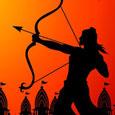What is Vasant Utsav?
Annually celebrated in March, the beautiful festival "Vasant Utsav" is an occassion to invite the colourful spring season with utmost warmth. Know all about this yearly event, its origins and its celebration. If you like this fascinating article on "Vasant Utsav", click here and refer it to your friends and dear ones. May you have a grand spring celebration!
When the chilly winds of the cold winter give way to gentle warm breezes and the bare branches of trees begin to bear new green leaves, the mind naturally finds a reason for celebration. "Vasant Utsav" is the expression of this joy of the mind and a lovely way to welcome the beautiful spring season.
The "Vasant Utsav" is one of the most ancient Aryan festivals. References to this magnificient occassion can be found in ancient Sanskrit texts like the "Dashakumar Charit" and "Garud Puran". The festival also finds mention in the works of the great poet Kalidas who referred to it as “Madan Utsav”.
It was the great Nobel Laureate Rabindranath Tagore who brought "Vasant Utsav" back to its former glory. A lover of the spring season, the poet had introduced the festival in 1925 in the Bishwabharati University in Shantiniketan which he himself had established. This spring festival is celebrated at the same time as the more popular Holi or Dolyatra which commemorates the innocent playing of Lord Krishna with colours with the girls of the cowherd.
The occassion witnesses enthusiastic celebrations by the local people of Bolepur (home to the Bishwabharati University) and the students of Tagore's educational institution. Students of the university dress up in bright yellow (the colour symbolizing the spring season) attires and organise a number of cultural programs that involve songs, dances, dramatic performances and recitation of poetry based on spring. They dance and sing their ways through Amrakunja (the Mango grove located inside the Santiniketan Campus).
The popular Holi tradition of playing with 'Abeer' is also a part of the Vasant Utsav. However, the coloured powder is made here from vegetable dyes to avoid health hazards caused by harmful ingredients of industrial colours. The festive day has students smearing each other's face and head with these natural colors and exchanging festive wishes. Various open-air performances are held on the festive day.
"Baul gaan" (songs traditionally sung by a group of mystic minstrels from Bengal) is an integral part of the Vasant Utsav observances. These beautiful and thought-provoking songs, sung to the accompaniment of the unique string instrument "Ektara", speak of life and faith in a distinct style.
Since its inception, Vasant Utsav has come a long way earning nationwide renown and even turning the Biswabharati campus into a very popular hotspot for international tourists during March. As always, it remains an integral part of the Bengali culture. It is the celebration of nature, colours and youth.
The "Vasant Utsav" is one of the most ancient Aryan festivals. References to this magnificient occassion can be found in ancient Sanskrit texts like the "Dashakumar Charit" and "Garud Puran". The festival also finds mention in the works of the great poet Kalidas who referred to it as “Madan Utsav”.
It was the great Nobel Laureate Rabindranath Tagore who brought "Vasant Utsav" back to its former glory. A lover of the spring season, the poet had introduced the festival in 1925 in the Bishwabharati University in Shantiniketan which he himself had established. This spring festival is celebrated at the same time as the more popular Holi or Dolyatra which commemorates the innocent playing of Lord Krishna with colours with the girls of the cowherd.
The occassion witnesses enthusiastic celebrations by the local people of Bolepur (home to the Bishwabharati University) and the students of Tagore's educational institution. Students of the university dress up in bright yellow (the colour symbolizing the spring season) attires and organise a number of cultural programs that involve songs, dances, dramatic performances and recitation of poetry based on spring. They dance and sing their ways through Amrakunja (the Mango grove located inside the Santiniketan Campus).
The popular Holi tradition of playing with 'Abeer' is also a part of the Vasant Utsav. However, the coloured powder is made here from vegetable dyes to avoid health hazards caused by harmful ingredients of industrial colours. The festive day has students smearing each other's face and head with these natural colors and exchanging festive wishes. Various open-air performances are held on the festive day.
"Baul gaan" (songs traditionally sung by a group of mystic minstrels from Bengal) is an integral part of the Vasant Utsav observances. These beautiful and thought-provoking songs, sung to the accompaniment of the unique string instrument "Ektara", speak of life and faith in a distinct style.
Since its inception, Vasant Utsav has come a long way earning nationwide renown and even turning the Biswabharati campus into a very popular hotspot for international tourists during March. As always, it remains an integral part of the Bengali culture. It is the celebration of nature, colours and youth.

 Ram Navami
Ram Navami Passover
Passover Good Morning
Good Morning